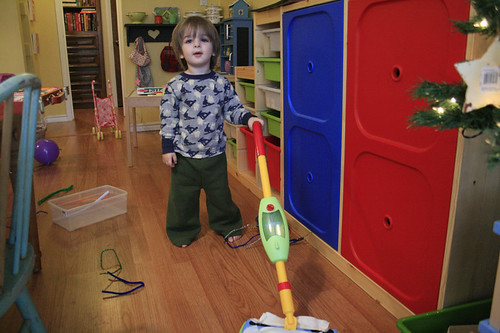
Chances are, she'll make something. Using every color, and art tool available.

Twice. She'll ask for things to glue and practice cutting with her new scissors. All the new pieces she just cut, has to be glued down also. I give Noah his own canvas to work with, and he prefers to swirl his materials in the glue instead. So I let him.

She asks for pipe cleaners and then cuts those into small pieces. Noah walks away in mid coloring - he's through. Wandering around the room, he finds the swifer. So he starts to clean.

And chances are - if you have a clean playroom, they'll want to make something else. Again.
When inspiration strikes, the supplies have to be ready. We were overwhelmed with the art box Grandma bought Ava for her birthday - with a personalized name plate on top. When Aaron saw this briefcase, his OCD kicked in. And I assured him that I'll do my best to remind her to put every piece back as she uses them. After all, they are "Ava's." The box says so.
Having such a special gift, with more than 200 pieces can make you a little dizzy. We haven't lost a piece yet, and when considering how much she loves to make things, I don't think we will [anytime soon]. Unless of course, other non-art-lovers get a hold of it and make off with the blues and greens.
There's so much value into investing in a box like this - and I would encourage everyone to create something like this for your budding artist.
Start an Art Box:
1. Use a box small enough for her to carry. Preferably one that has a closing mechanism in case she wants to do a twirl before getting started.
2. Gather supplies. You may have many of them at home already, so gather these then visit your local art supply store to look for more creative opportunities: pastels, acrylics, water colors, pencils, crayons, markers [fat and thin ones], a set of paints, and of course, glitter...
3. Organize your box by lining the bottom with a tray that has several components. Or get several small cardboard boxes and label them. You don't have to fill the entire box the first day. Rotate materials or add more colors as others are finished. This keeps her box interesting - and inspiring to try something different each art day.
4. Keep a junk box close by. Yes, junk is inspirational. Think about textures and the ongoing flow of materials that pass through our hands on the way to the garbage. Tissue paper, aluminum foil, popsicle sticks, bubble wrap, cardboard, construction and corrugated papers...
5. Don't forget the tools that will help them get creative. Think brushes [for each style - water color or acrylic], sponges, stamps, scissors, glue, and stencils...
The success of the art box comes directly from the time spent together. Sharing materials, exchanging ideas, and helping each other with suggestions are the added bonuses to a toddler's developmental years.
I love it when Ava tells me, "Mommy, you need more red here..."

No comments:
Post a Comment
Thanks for sharing - I will respond to your comment here as well so check back! xo